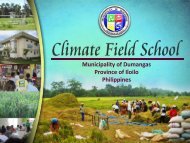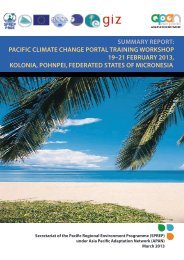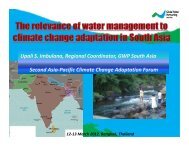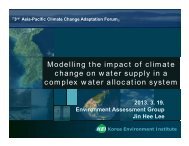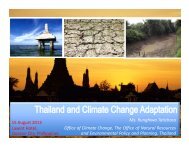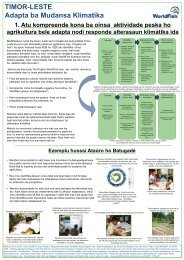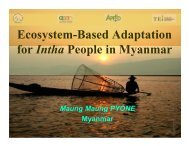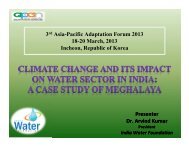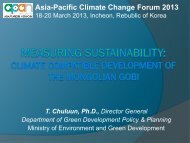PDF file (2.44 MB) - Asia Pacific Adaptation Network
PDF file (2.44 MB) - Asia Pacific Adaptation Network
PDF file (2.44 MB) - Asia Pacific Adaptation Network
You also want an ePaper? Increase the reach of your titles
YUMPU automatically turns print PDFs into web optimized ePapers that Google loves.
34Parallel Sessions 3: Institutional and Economic Aspects of Climate Change Impacts and <strong>Adaptation</strong>The country has nevertheless achieved a lot by way of ensuring environmental and food security.Among the notable and more recent policy and regulatory initiatives include the Bangladesh ClimateChange Strategy and Action Plan (BCCSAP); the National <strong>Adaptation</strong> Plan of Action (2005); ClimateChange Trust Act (2010); 15th Constitution Amendment (2011); and the Bangladesh Water Act, (2012,draft).Specifically for the agricultural sector, the government is promoting the adoption of appropriatefarm technologies and enhancing the skills and capabilities of farmers for them to realise theirpotential yields and reduce their post-harvest losses, e.g., growing of crops suitable for various agroecosystems;adoption of varieties that are tolerant to climate-related stresses; and use of elevatedgarden beds to prevent waterlogging of crops.For Bangladesh, the water sector is clearly the most vulnerable to impacts of climate change. In thisregard, the country can count successes in adaptation as reflected in its shift from flood control to aflood management approach. The government has likewise taken similar adaptation measures in therelated areas of storm surge/cyclones/sea level rise (SLR) management, drought management, watersupply and sanitation, and urban drainage.There are as many opportunities as there are challenges that need to be addressed. However,the government is acutely aware that its water issues are primarily regional and these requirethe cooperation of the GBM countries. Issues for consideration include 1) flood management; 2)transboundary water sharing and dry season flow management (with India and Myanmar); 3)hydropower development; 4) sediment management to improve (river) navigation and waterconnectivity; 5) water quality management; and 7) climate change mitigation and adaptation onthe Himalayan Range. The key role of the international community on the sharing of appropriatetechnologies, strategies, and approaches and financial assistance was also underscored.Q: (Dr. Kakar to Dr. Uprety) You mentioned rising temperature of .06 o C - what is the source of yourfigure? Also, are there no other factors outside of climate change, such as vested interests in thecommunity, that brought about forest fires in your country?A: The figure on annual rise in temperature at .06 o C comes from our Ministry of Environment. Youare right, not all the events related to forest fires are effects of climate change. Illegal activitiesdo happen, but to a large extent the fires are triggered during times of drought and in spite ofthe establishment of numerous fire lines maintained by forest user groups.Q: (Dr. Bui Dung The to Dr. Pham Khanh Nam) You showed a usual gap between subjective(perceived) and objective (what really happened) probabilities of flood depth. How do yourelate these outcomes to the reliability or accuracy of other valuation studies using contingentvaluation method (CVM) and choice modeling to get the benefits of some flood preventionmethods? CVM and choice modeling also depend on people’s subjective assessment. Whatwould be the implication of this on the analysis and interpretation of findings?A: You raised an important issue in research methodology regarding the valuation of theenvironment and natural resources for rural services. Our current methodology on CVM andchoice modeling is grounded on neoclassical economics, which assumes that people are rationaland have perfect understanding of the world. Therefore, theory would assume no gap betweensubjective and objective probabilities of flood occurrence. You pointed out a key issue onreliability and accuracy of CVM and choice modeling. That is why behavioural economics wantsto develop models that would bridge the gap between what people perceive and reality. Thus,there is still a lot of room for us to address this gap.Q: (Dr. Zafaralla to Dr. Alamgir) You recommended a shift from ‘solo’ approach to communityapproach in solving problems caused by climate change. Please cite an example where thecommunity approach proved more successful than the individual approach. Also, what is it aboutthe culture in Bangladesh that makes the community approach more appropriate?International Conference on Climate Change Impactsand <strong>Adaptation</strong> for Food and Environmental SecurityConference Summary Report




